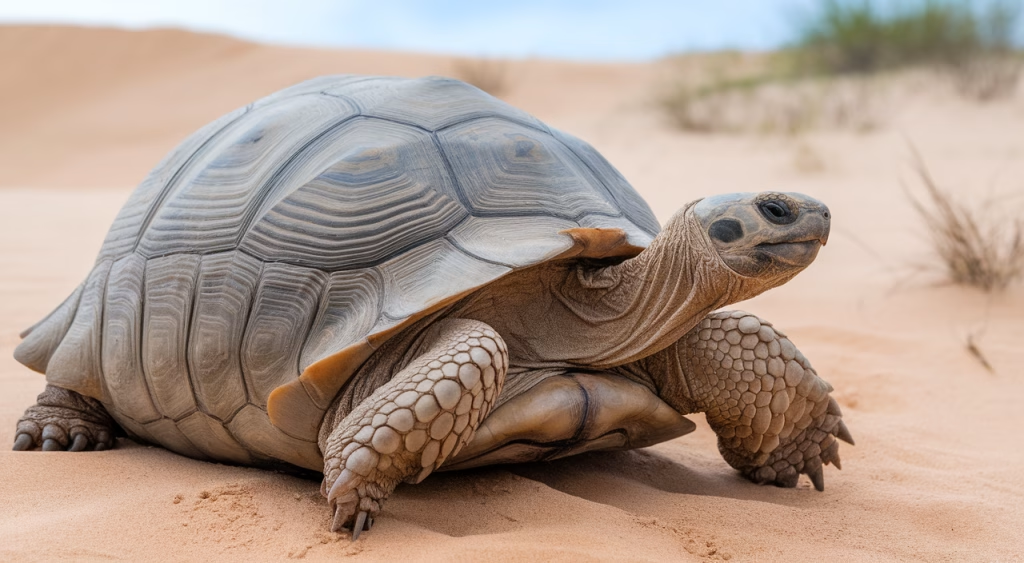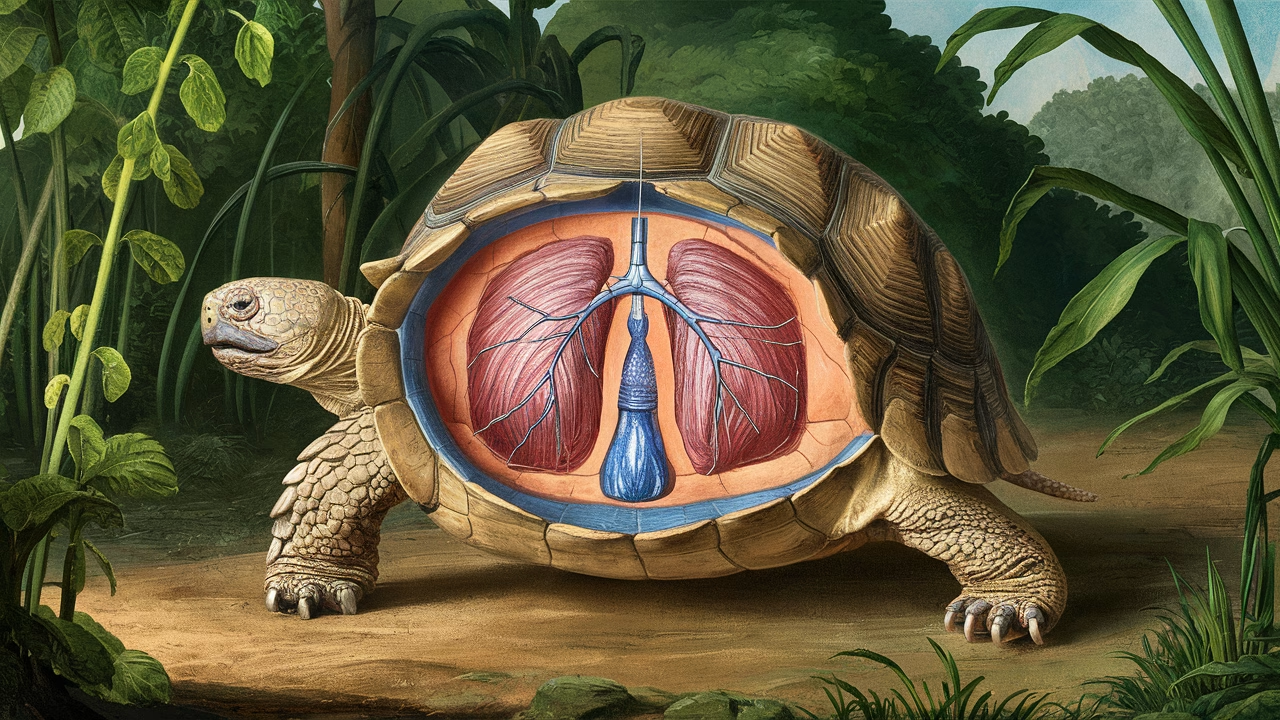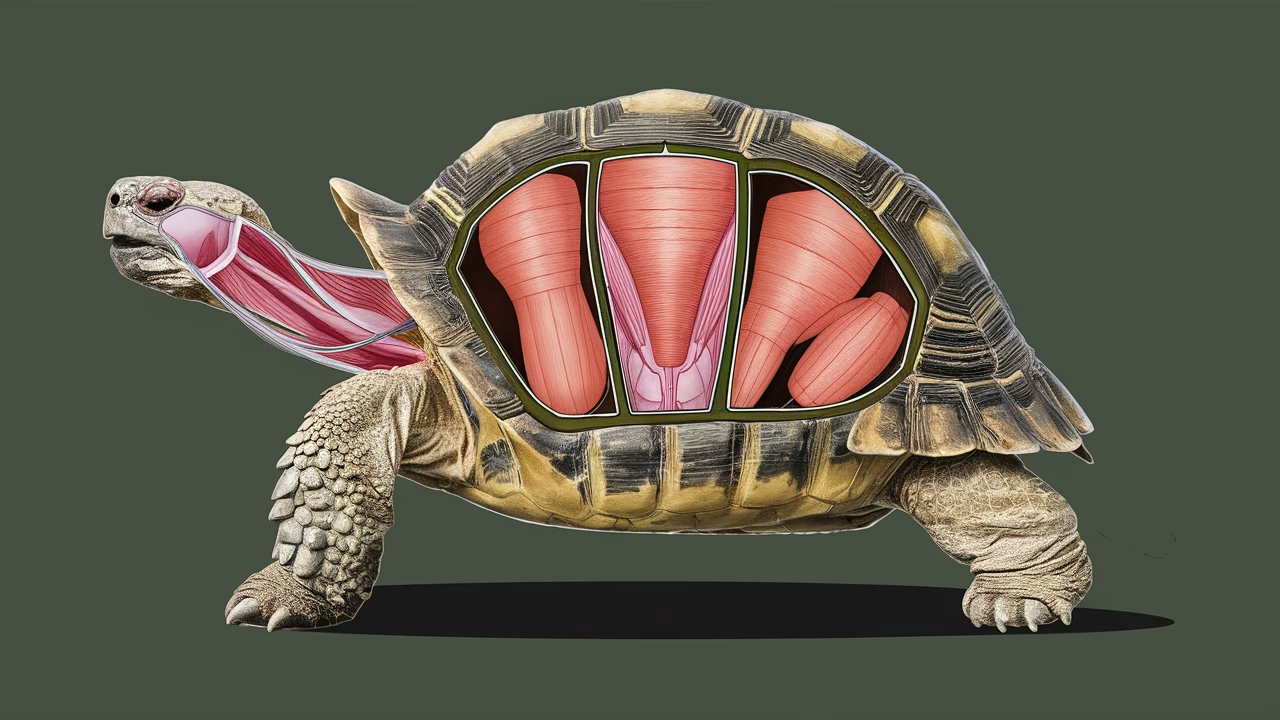How do tortoises breathe without expanding their ribs?
Because their ribs are fused to their shell, tortoises can’t expand their chests like mammals. Instead, they use specialized muscle movements in their limbs and body cavity to create pressure changes that allow them to inhale and exhale.
TL;DR: Tortoise Breathing Explained
- Shell Challenges: Tortoises cannot expand their chest because their ribs are part of their shell.
- Muscle Power: They rely on muscles near the limbs and girdles to create negative pressure, pulling air into the lungs.
- Breathing Adaptation: Their version of a diaphragm isn’t like ours, but serves a similar function using muscle sheets inside the body.
- Comparative Biology: Turtles and tortoises share this respiration method, yet variations occur based on habitat (terrestrial vs. aquatic).
Introduction to the Tortoise Respiratory System
If you’ve ever watched a tortoise moving slowly across the ground, you might wonder how these shelled creatures manage to breathe at all. When you examine the tortoise respiratory system closely, you discover a remarkable biological adaptation that’s been perfected over millions of years. While we humans breathe by expanding our chest cavity, tortoises had to evolve an entirely different approach to solve the breathing challenge.
Understanding how tortoises breathe reveals one of nature’s most ingenious solutions. Since their turtle ribs are completely fused to their protective shells, these reptiles can’t rely on the ribcage expansion that mammals use. Instead, tortoises breathe through an intricate network of specialized muscles that work together like a biological bellows system, creating the pressure changes needed to move air in and out of their lungs.
This muscle-powered breathing mechanism isn’t just fascinating from a scientific perspective—it’s essential knowledge for anyone caring for these amazing creatures or studying reptile biology.
Understanding the Role of Muscles in Tortoise Breathing
The secret to how tortoises breathe lies in their sophisticated muscular system that replaces the function of moveable ribs. While mammals rely on a dome-shaped diaphragm muscle to create breathing movements, tortoises use a completely different anatomical solution.
In tortoises, a specialized muscle sheet called the tortoise diaphragm (technically known as the postpulmonary septum) acts as the primary breathing muscle. This membrane separates the lung chamber from other internal organs and coordinates with additional muscle groups to power respiration.
Here’s exactly how the tortoise breathing mechanism works:
| Structure | Function in Breathing |
|---|---|
| Postpulmonary Septum (Tortoise Diaphragm) | Separates lungs from organs and maintains internal pressure zones |
| Transverse Abdominal Muscles | Contract to create negative pressure, pulling air into lungs |
| Serratus and Oblique Muscles | Assist in compressing and expanding the body cavity to push air out |
| Leg and Shoulder Girdle Movement | Shifts internal organs, creating space for lungs to expand |
This breathing process explains why tortoises often appear to be moving their limbs slightly even when resting—they’re actually facilitating their respiratory cycle through these subtle muscle contractions.
Comparison with Turtle Breathing Mechanism
While all tortoises are technically turtles, the turtle breathing mechanism varies significantly between land-dwelling tortoises and their aquatic relatives. Understanding these differences helps explain how tortoises breathe compared to other turtle species.
Aquatic turtles have evolved additional respiratory adaptations that terrestrial tortoises lack. Sea turtles and freshwater species can supplement their lung breathing with cloacal respiration—essentially breathing through specialized tissues near their rear end during long underwater periods. This allows them to extract dissolved oxygen from water.
Tortoises, however, rely exclusively on their muscular lung ventilation system. Since they live in dry terrestrial environments, they’ve perfected the muscle-based breathing technique rather than developing alternative oxygen absorption methods. Both types of turtles share the same fundamental challenge of immobile turtle ribs, but their solutions reflect their different habitats and lifestyles.
Adaptations for Survival: How Tortoises Breathe Without Ribs
The question of how do tortoises breathe without ribs reveals one of evolution’s most elegant solutions to a mechanical challenge. When their ribs became permanently fused to their protective shells, tortoises had to completely redesign their respiratory system.
The tortoise breathing adaptation centers on coordinated muscle movements that create internal pressure changes. Their lungs remain fixed against the top of their shell, but air flow is controlled entirely by muscular contractions that compress and expand their body cavity. The forelimbs and hindlimbs don’t just provide locomotion—they’re integral parts of the breathing apparatus.
This system has important limitations that explain tortoise behavior. When a tortoise is flipped upside down, it faces genuine respiratory distress because the muscle groups can’t function properly in that position. Similarly, tortoises are naturally slow-moving partly because rapid movement would interfere with their breathing rhythm. Their entire lifestyle reflects the constraints and capabilities of their unique respiratory system.
Understanding how tortoises breathe also explains why these animals thrive in arid environments where other reptiles struggle. Their efficient, muscle-powered ventilation system works reliably in dry conditions where water-dependent breathing methods would fail.
Conclusion: Insights into the Amazing World of Tortoise Physiology
Now you understand the remarkable answer to how tortoises breathe despite having no expandable ribcage. Their muscle-powered respiratory system represents millions of years of evolutionary refinement, proving that nature finds ingenious solutions to seemingly impossible challenges.
Every time you observe a tortoise making those subtle limb movements, you’re witnessing a sophisticated breathing mechanism in action. These small shifts aren’t random—they’re precisely coordinated muscle contractions that keep these amazing creatures alive and thriving in environments where their unique adaptations provide distinct advantages.
This knowledge helps us better appreciate and care for tortoises, whether in the wild or in captivity, by understanding the delicate balance of their respiratory needs.
Frequently Asked Questions
How does a turtle breathe if it can’t move its ribs?
Both turtles and tortoises use muscle movement to create pressure changes in the body cavity, allowing them to breathe. Some aquatic turtles also use cloacal respiration.
What is a tortoise diaphragm, and how does it work?
The tortoise diaphragm is a muscular membrane that separates the lungs from other organs. It aids in breathing by maintaining pressure differences that help move air in and out of the lungs.
Do tortoises breathe through their skin?
No, tortoises cannot breathe through their skin. Unlike amphibians, tortoises rely exclusively on lungs and muscular movements for respiration.
Can tortoises drown if submerged?
Yes. Unlike some aquatic turtles, tortoises cannot hold their breath for long periods and are at high risk of drowning if kept underwater.
Can tortoises breathe while asleep?
Yes, tortoises continue to breathe while asleep thanks to involuntary muscle movements that maintain their respiratory rhythm.
Does shell shape affect how tortoises breathe?
To an extent. Domed shells found in land tortoises provide more space for internal organs, but the rigid structure always limits chest expansion—hence the reliance on internal musculature.
No. While they share similarities, many aquatic turtles have adapted to their environment by developing supplemental respiratory techniques like cloacal respiration.
{“@context”:”https://schema.org”,”@type”:”BlogPosting”,”headline”:”How Do Tortoises Breathe Without Ribs? The Amazing Science Explained”,”description”:”Discover how tortoises breathe despite rigid shells. Learn about their unique respiratory system and muscle-based breathing mechanism.”,”datePublished”:”2024-06-05″,”publisher”:{“@type”:”Organization”,”name”:”Furfactips”,”logo”:{“@type”:”ImageObject”,”url”:”https://furfactips.com/wp-content/uploads/furfactips-logo.png”}},”mainEntityOfPage”:{“@type”:”WebPage”,”@id”:”https://furfactips.com/”},”keywords”:[“tortoises breathe”,”tortoise diaphragm”,”tortoise respiratory system”,”turtle ribs”,”turtle breathing mechanism”,”how do tortoises breathe without ribs”,”turtle respiratory system explained”,”the science behind tortoise breathing mechanism”],”mainEntity”:[{“@type”:”Question”,”name”:”How does a turtle breathe if it can’t move its ribs?”,”acceptedAnswer”:{“@type”:”Answer”,”text”:”Both turtles and tortoises use muscle movement to create pressure changes in the body cavity, allowing them to breathe. Some aquatic turtles also use cloacal respiration.”}},{“@type”:”Question”,”name”:”What is a tortoise diaphragm, and how does it work?”,”acceptedAnswer”:{“@type”:”Answer”,”text”:”The tortoise diaphragm is a muscular membrane that separates the lungs from other organs. It aids in breathing by maintaining pressure differences that help move air in and out of the lungs.”}},{“@type”:”Question”,”name”:”Do tortoises breathe through their skin?”,”acceptedAnswer”:{“@type”:”Answer”,”text”:”No, tortoises cannot breathe through their skin. Unlike amphibians, tortoises rely exclusively on lungs and muscular movements for respiration.”}}]}





